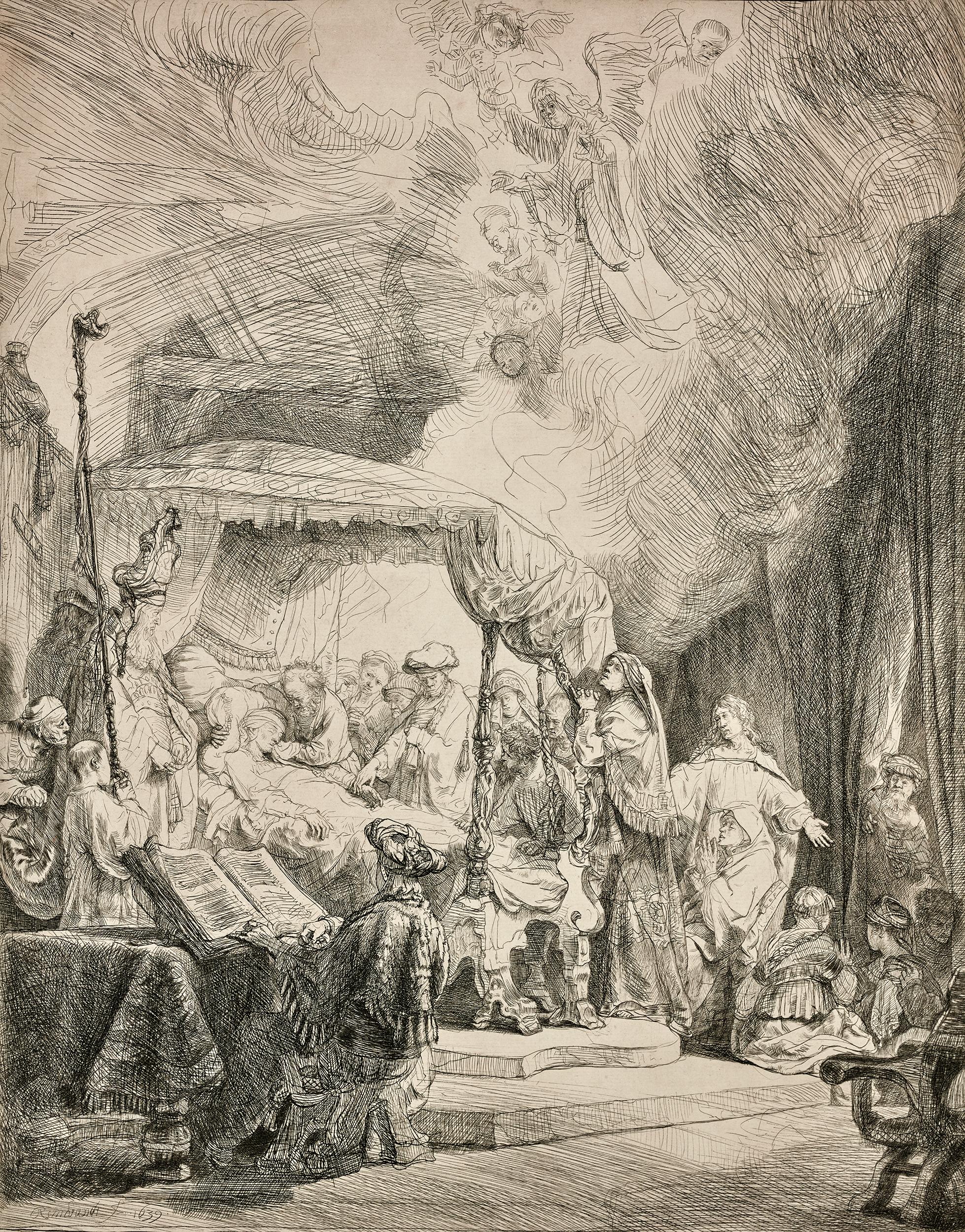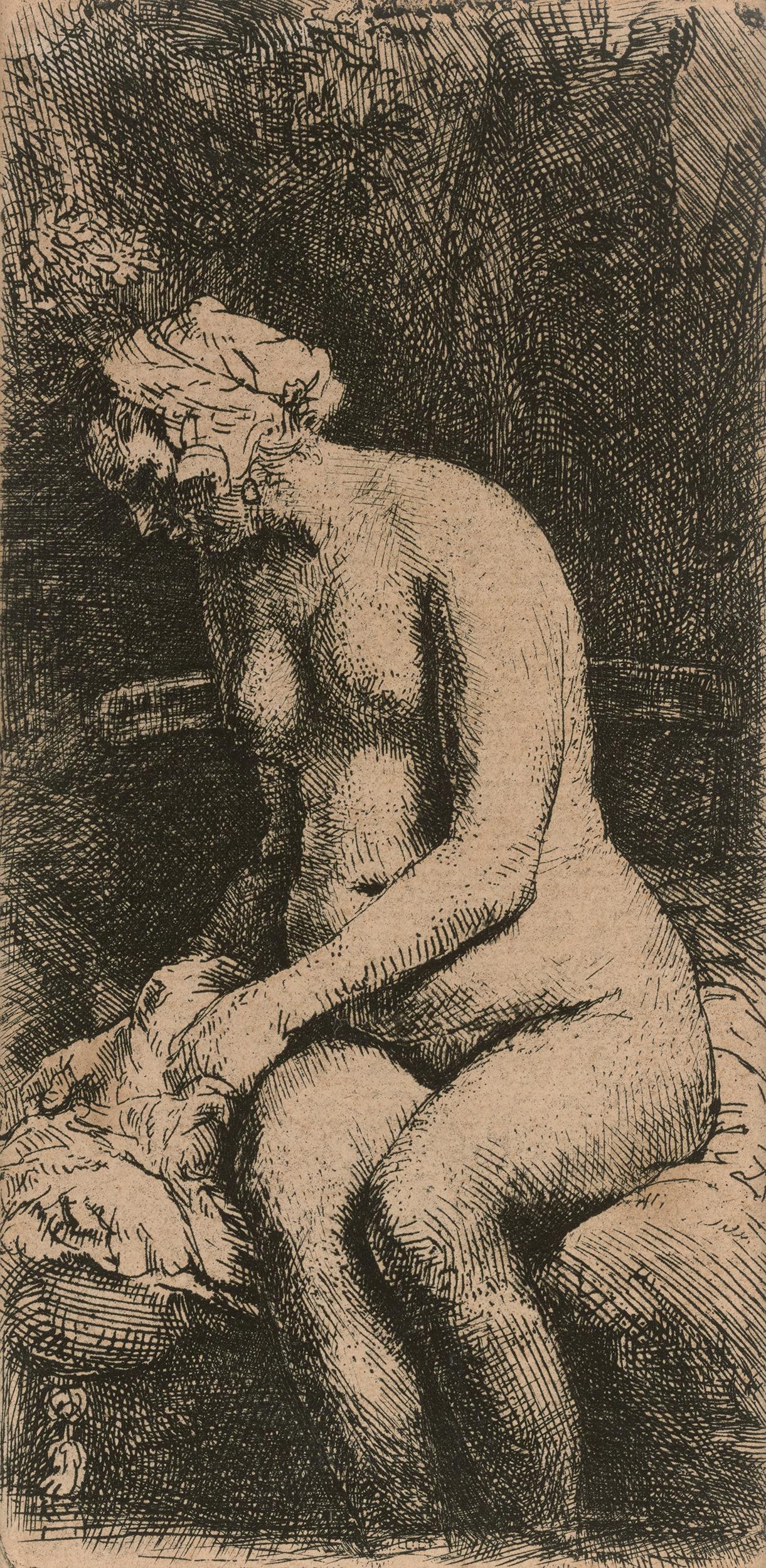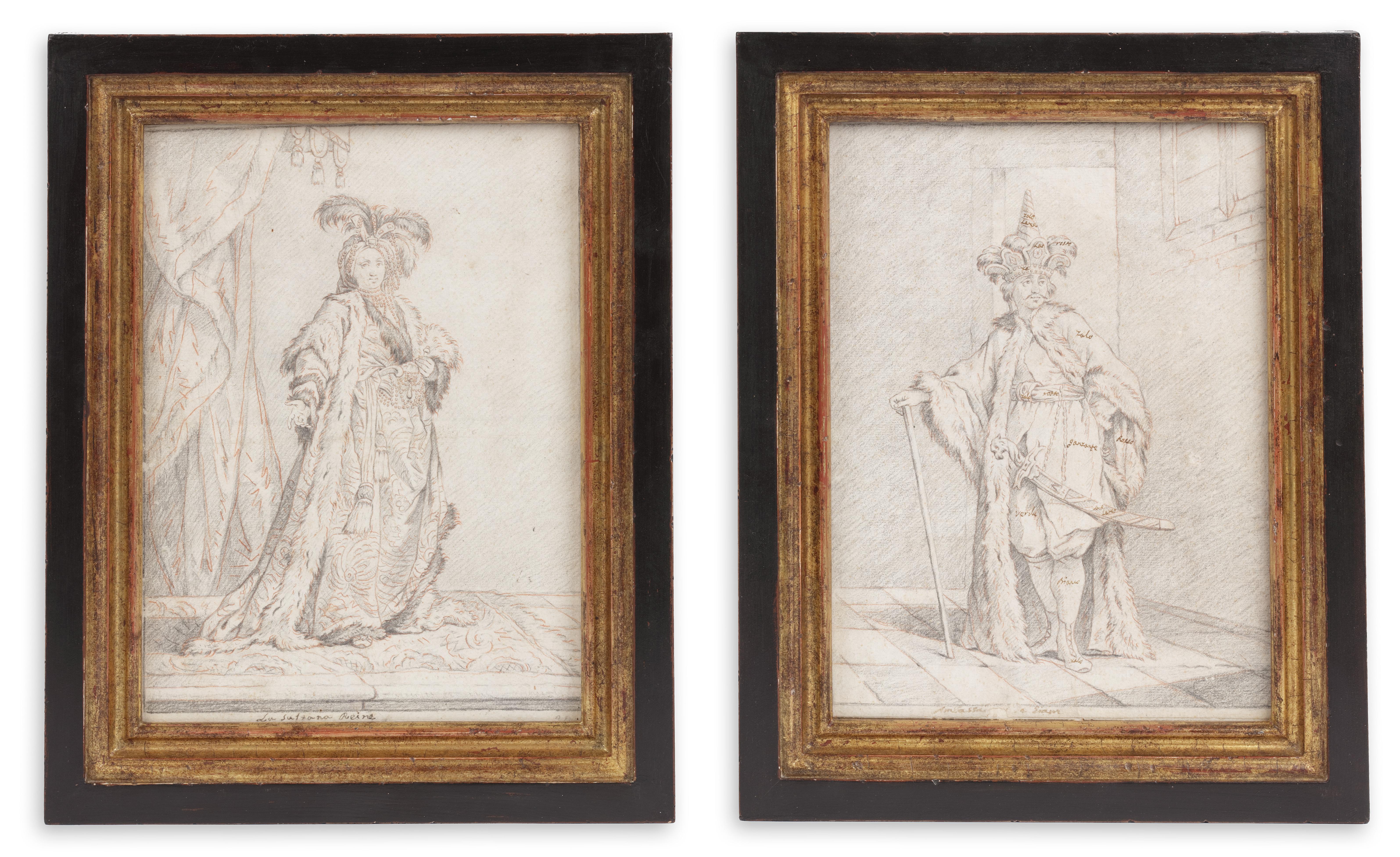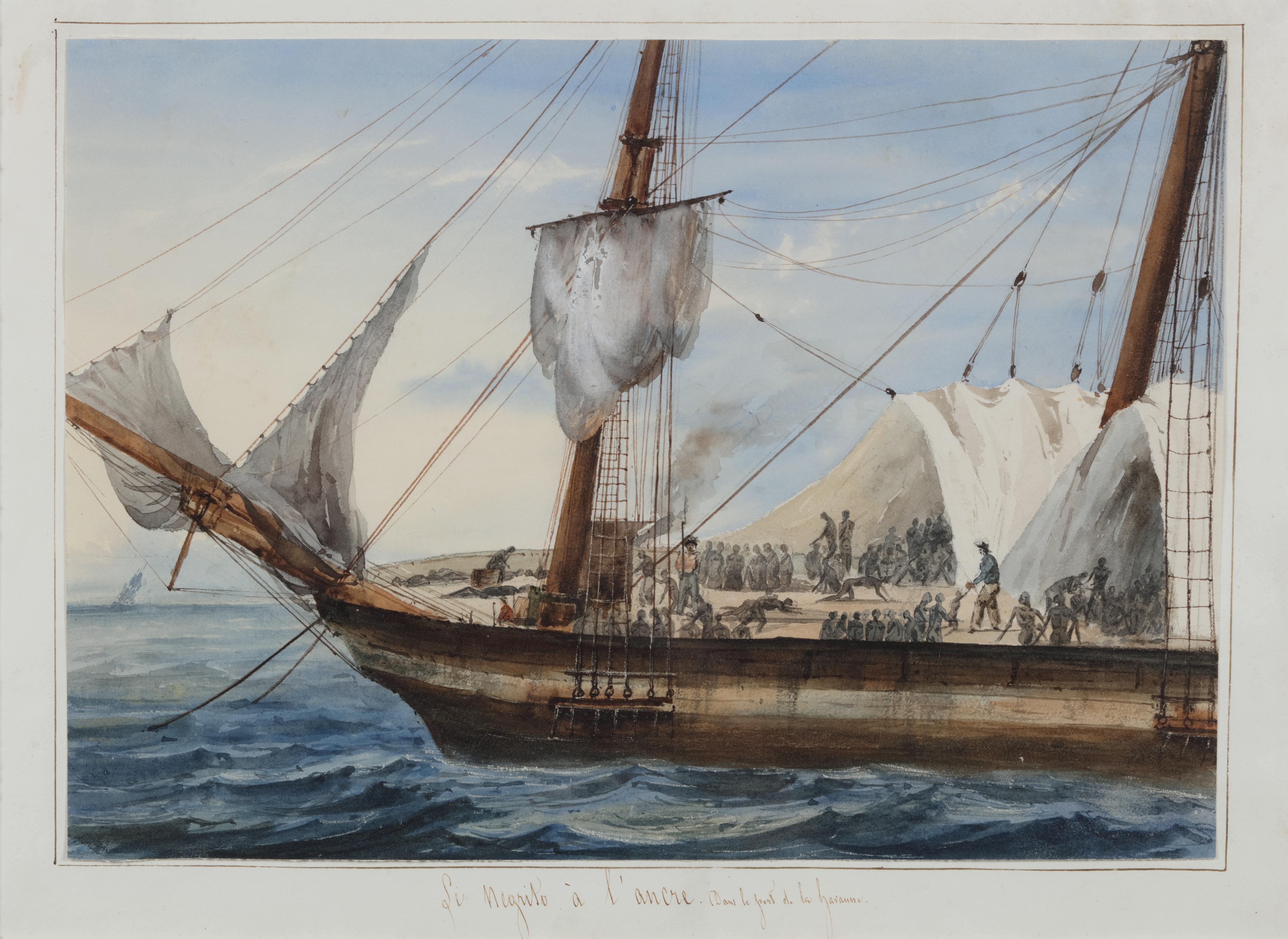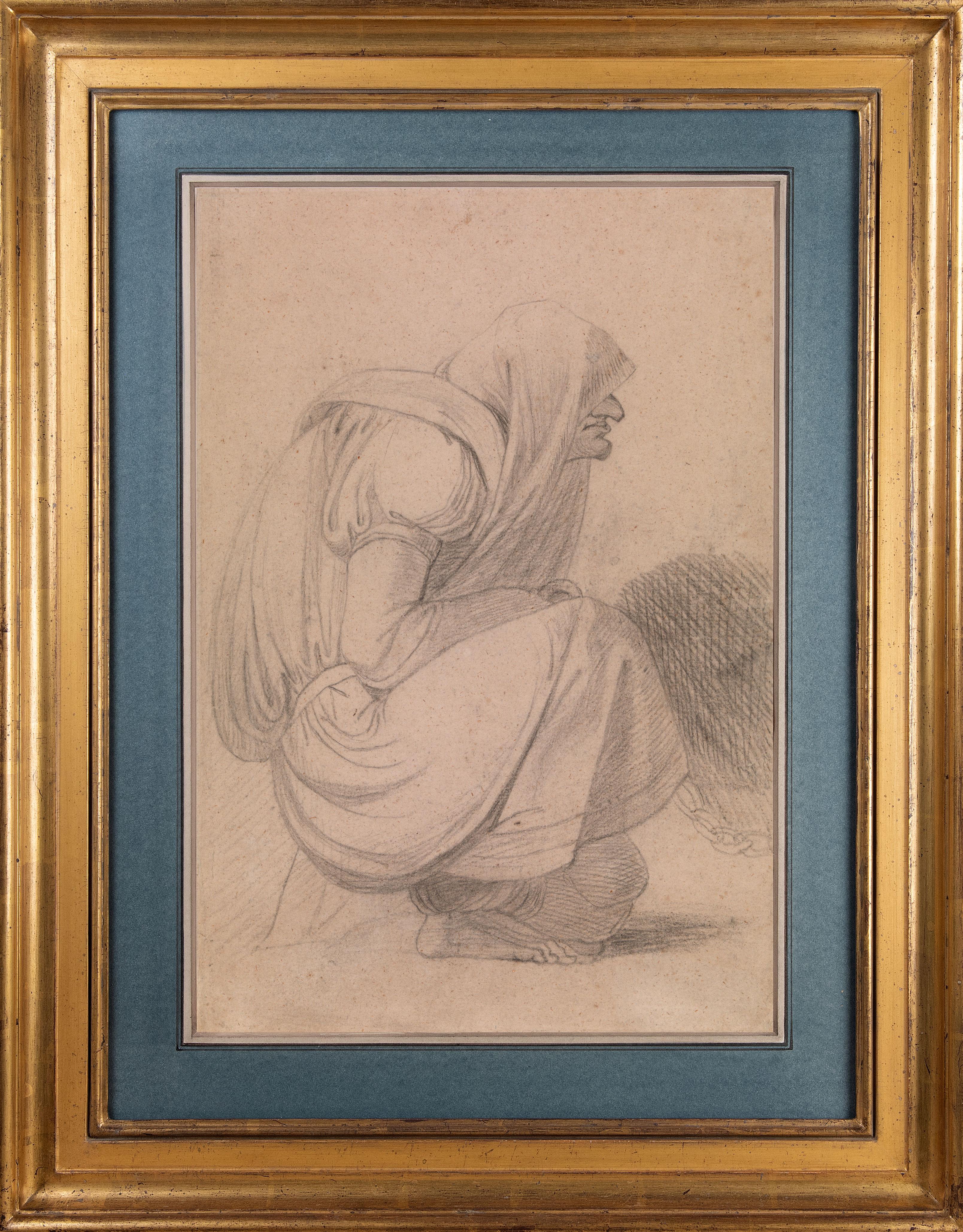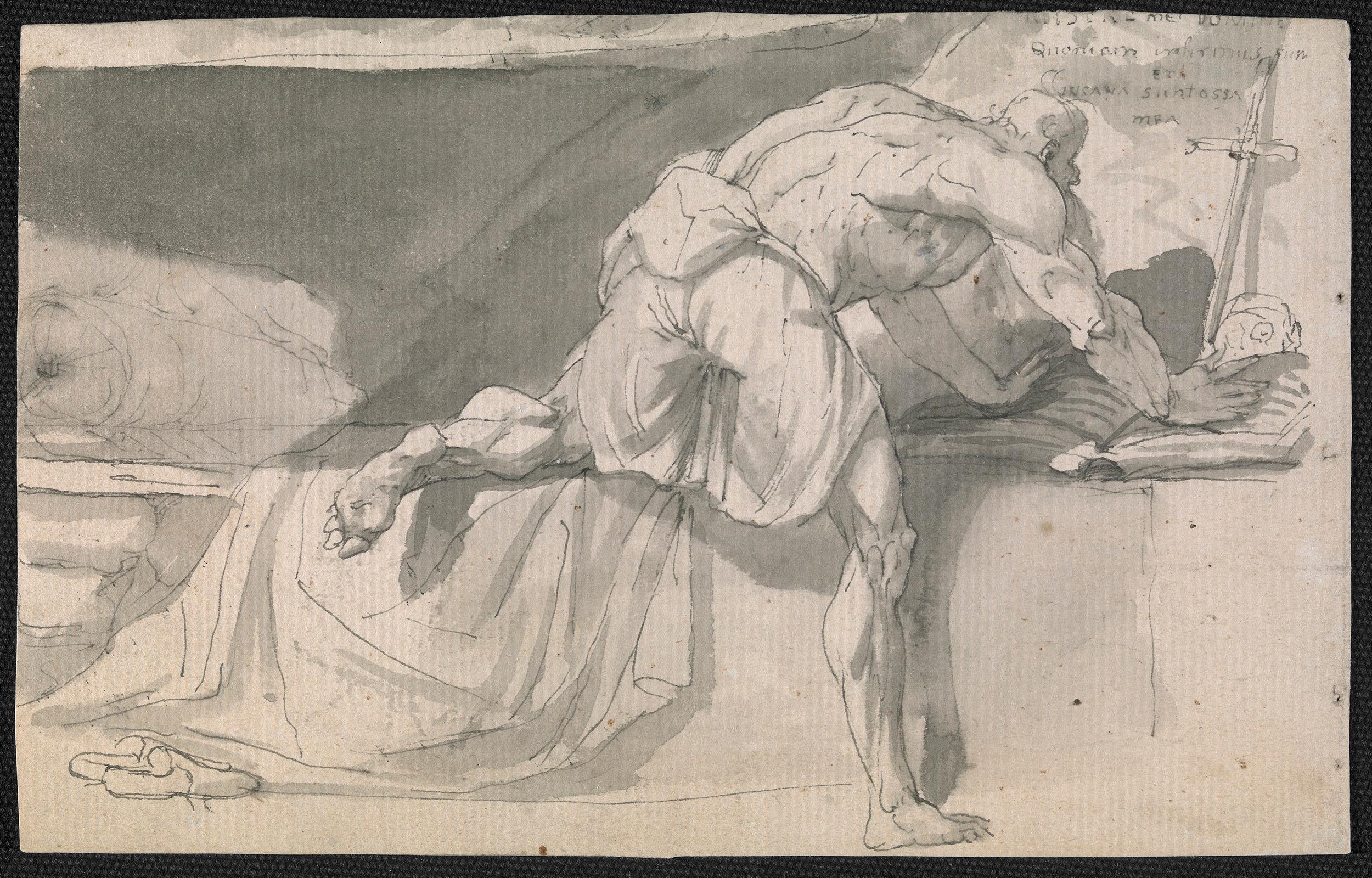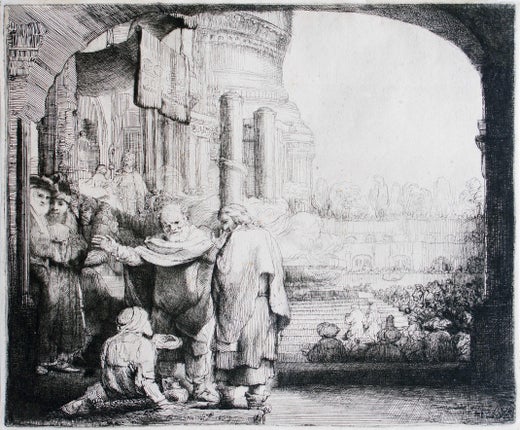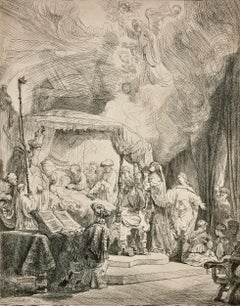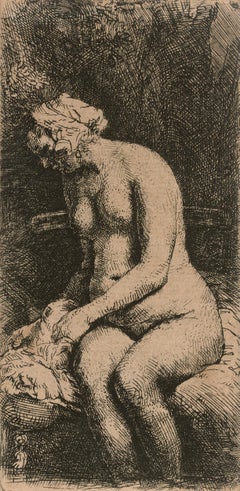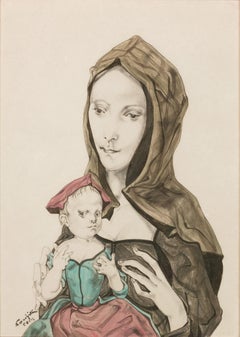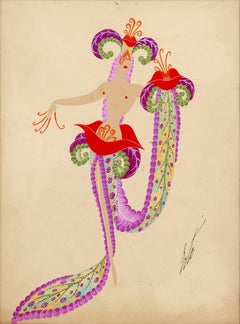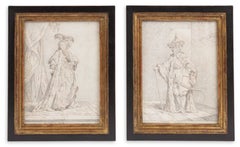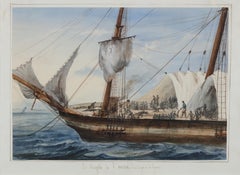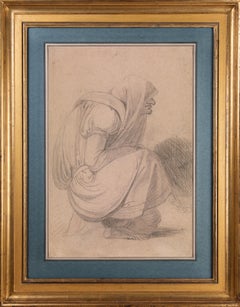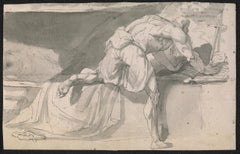Items Similar to Man with Divided Cap by Rembrandt van Rijn
Want more images or videos?
Request additional images or videos from the seller
1 of 8
Rembrandt van RijnMan with Divided Cap by Rembrandt van Rijn1640
1640
About the Item
Rembrandt van Rijn
1606-1669 Dutch
Man with Divided Cap
Etching and drypoint on paper
First state of three
Signed "Rembrandt" (upper left)
This exceptional etching was composed by one of the supreme geniuses in the history of art, Rembrandt van Rijn. The subject of this particular impression, an old man wearing a divided fur cap, wears a calm countenance, gazing to the right of the composition. Likely a portrait of a fictional character inspired by Biblical narratives, his long grizzled beard and wrinkled eyes bear testament to the sitter's age, appearing wise and weathered. Created at a critical moment in the prime of his career, the work exhibits Rembrandt’s unparalleled ability to create an expressive portrait with a simple etching needle and a copper plate. Other examples of this etching can be found in the Metropolitan Museum of Art, the Minneapolis Institute of Art and the Art Institute of Chicago, among others.
The son of a miller, Rembrandt Harmenszoon van Rijn is believed to have been born in Leiden on July 15, 1606. He studied first at the Latin School, and then was enrolled at the University of Leiden at the age of 14. He soon left to study art—first with a local master, Jacob van Swanenburch, and then, in Amsterdam, with Pieter Lastman, known for his historical paintings. Rembrandt was an exceptionally gifted student and mastered his art in a mere six months. By 22 years old, he returned to Leiden and was soon so highly regarded that he was able to take students of his own.
Though known today primarily for his paintings, Rembrandt’s fame spread outside of the Netherlands through his etchings. He made hundreds of etchings for most of his career, from 1626 to 1660, when he was forced to sell his presses. He did etchings of several subjects, including self-portraits, biblical subjects, saints and allegories, and his work was avidly admired and collected, even during his lifetime. These small works of art are still counted among the most beautifully executed in the whole of art history.
Etched 1640
Paper: 5 7/8" high x 5 3/8" wide (14.92 x 13.63 cm)
Frame: 20 1/4" high x 16 1/4" wide x 7/8" deep (51.44 x 41.28 x 2.94 cm)
Literature:
Bartsch, Adam. Le Peintre-Graveur, Vol. 1. Vienna: Kunstverlag, 1803. No. 265, State I/II
Hind, Arthur M. A Catalogue of Rembrandt’s Etchings. London: Methuen, 1923. No. 170, State I/III
Biörklund, George. Rembrandt's Etchings: True and False. Stockholm: Esselte, 1968. No. 40-A, State I/II
Münz, Ludwig. Rembrandt’s Etchings. London: Phaidon, 1952. No. 59
New Hollstein Dutch & Flemish Etchings, Engravings and Woodcuts 1450–1700: Rembrandt, ed. Erik Hinterding and Jaco Rutgers. Ouderkerk aan den IJssel: Sound & Vision Publishers, 2013. No. 182, State I/II
- Creator:Rembrandt van Rijn (1606 - 1669, Dutch)
- Creation Year:1640
- Dimensions:Height: 20.25 in (51.44 cm)Width: 16.25 in (41.28 cm)Depth: 1 in (2.54 cm)
- Medium:
- Movement & Style:
- Period:
- Condition:
- Gallery Location:New Orleans, LA
- Reference Number:Seller: 32-10821stDibs: LU18616491672
Rembrandt van Rijn
Rembrandt was the most influential 17th Century Dutch painter. After years of early success as a portrait painter, his life was beset by financial hardship and personal tragedy. He continued to paint portraits and develop etchings. Rembrandt's portraits of his contemporaries, self-portraits and illustrations of scenes from the Bible are regarded as his greatest creative triumphs. His self-portraits form a unique and intimate autobiography, in which the artist surveyed himself without vanity and with the utmost sincerity. Like many artists of the Dutch Golden Age, such as Jan Vermeer of Delft, Rembrandt was also an avid art collector and dealer. Rembrandt never went abroad, but he was considerably influenced by the work of the Italian masters and Netherlandish artists who had studied in Italy, like Pieter Lastman, the Utrecht Caravaggists, Flemish Baroque, and Peter Paul Rubens. Rembrandt's foremost contribution in the history of printmaking was his transformation of the etching process from a relatively new reproductive technique into a true art form, along with Jacques Callot. His reputation as the greatest etcher in the history of the medium was established in his lifetime and never questioned since. Few of his paintings left the Dutch Republic while he lived, but his prints were circulated throughout Europe, and his wider reputation was initially based on them alone.
About the Seller
5.0
Vetted Professional Seller
Every seller passes strict standards for authenticity and reliability
Established in 1912
1stDibs seller since 2013
16 sales on 1stDibs
Typical response time: 9 hours
- ShippingRetrieving quote...Shipping from: New Orleans, LA
- Return Policy
Authenticity Guarantee
In the unlikely event there’s an issue with an item’s authenticity, contact us within 1 year for a full refund. DetailsMoney-Back Guarantee
If your item is not as described, is damaged in transit, or does not arrive, contact us within 7 days for a full refund. Details24-Hour Cancellation
You have a 24-hour grace period in which to reconsider your purchase, with no questions asked.Vetted Professional Sellers
Our world-class sellers must adhere to strict standards for service and quality, maintaining the integrity of our listings.Price-Match Guarantee
If you find that a seller listed the same item for a lower price elsewhere, we’ll match it.Trusted Global Delivery
Our best-in-class carrier network provides specialized shipping options worldwide, including custom delivery.More From This Seller
View AllThe Death of the Virgin by Rembrandt van Rijn
By Rembrandt van Rijn
Located in New Orleans, LA
Rembrandt van Rijn
1606-1669 Dutch
The Death of the Virgin
Etching and drypoint on laid paper
State II of V
Signed and dated "Rembrandt f. 1639" (lower left)
In The Death of the ...
Category
17th Century Old Masters Figurative Drawings and Watercolors
Materials
Laid Paper, Drypoint, Etching
Woman Bathing Her Feet in a Brook by Rembrandt van Rijn
By Rembrandt van Rijn
Located in New Orleans, LA
Rembrandt van Rijn
1606-1669 Dutch
Woman Bathing Her Feet in a Brook
Etching on paper
New Hollstein's 309, second state of II
Signed and dated "Rembrandt f. 1658" (upper left)
Created from observations of a live model, this work started as a figure study before evolving into a more imaginative setting. It remains ambiguous whether the scene is set indoors, as suggested by the cushion the figure is seated on, or outdoors, indicated by the foliage in the background. The omission of her feet, suggesting they may be dangling in a brook, adds a charming touch to Rembrandt’s imaginative scene. The figure seems unaware of the viewer, presenting a dignified yet sensual demeanor.
The son of a miller, Rembrandt van Rijn is believed to have been born in Leiden on July 15, 1606. He studied first at the Latin School and then was enrolled at the University of Leiden at the age of 14. He soon left to study art—first with a local master, Jacob van Swanenburch, and then, in Amsterdam, with Pieter Lastman...
Category
17th Century Old Masters Figurative Drawings and Watercolors
Materials
Etching, Paper
Portrait of a Mother and Child by Tsuguharu Foujita
By Léonard Tsuguharu Foujita
Located in New Orleans, LA
Tsuguharu Foujita
1886-1968 Japanese-French
Portrait of a Mother and Child
Signed “Foujita / Paris” (lower left)
Ink and watercolor on paper
An artistic luminary well ahead of his time, Tsuguharu Foujita burst onto the international art scene in the early 20th century as one of the most important artists in early Japanese modernism...
Category
20th Century Post-Impressionist Portrait Drawings and Watercolors
Materials
Paper, Ink, Watercolor
Les fleurs du mal by Erté
By Erte - Romain de Tirtoff
Located in New Orleans, LA
Erté (Romain de Tirtoff)
1892-1990 Russian-French
Fleurs du Mal(The Flowers of Evil)
Signed "Erté" (lower right)
Inscribed 114.6 (en verso)
Gouache on paper
Captivating and vibrant, this colorful gouache entitledFleurs du Mal showcases Erté's masterful creativity and keen eye. Inspired by Les Fleurs du mal, the famed volume of poems by French writer Charles Baudelaire, this ensemble marries light purple and green floral motifs with the suggestive form of red lips poised for a smooch. This daring yet feminine appearance encapsulates the Art Deco allure for which the artist's creations are cherished. The sophisticated arrangement emanates the fundamental richness and theatricality that can only be accomplished by Erté, often hailed as the "Father of Art Deco."
First published in 1857, Baudelaire's Les Fleurs du mal was controversial for its suggestive content and themes of decadence and eroticism. The volume provided a wealth of inspiration for Erté and he drew from several themes to create original fashion sketches...
Category
20th Century Art Deco Figurative Drawings and Watercolors
Materials
Paper, Gouache
The Buttonhole By Charles Spencelayh
By Charles Spencelayh
Located in New Orleans, LA
Charles Spencelayh
1865-1958 British
The Buttonhole
Signed “C.SPENCELAYH” (lower left) and inscribed “This Drawing was accepted into the Royal Academy but crowded out for want of ...
Category
20th Century Academic Figurative Drawings and Watercolors
Materials
Paper, Watercolor, Pencil
Piccadilly Circus by Fortunino Matania
By Fortunino Matania
Located in New Orleans, LA
Fortunino Matania
1881-1963 Italian
Piccadilly Circus
Signed “Matania” (center, on bus)
Watercolor and gouache on paper
This exceptional watercolor and gouache composition by fam...
Category
Early 20th Century Figurative Drawings and Watercolors
Materials
Paper, Watercolor, Gouache
You May Also Like
Costume drawings for ‘Ambassadeur de Siam’ and ‘La Sultana Reine’
Located in Amsterdam, NL
Joseph-Marie Vien (1716-1809)
‘Ambassadeur de Siam’ and ‘La Sultana Reine’
Both titled lower centre, the drawing of the ambassador inscribed with colours intended for the prints, e...
Category
Mid-18th Century Old Masters Figurative Drawings and Watercolors
Materials
Paper, Pencil
Portrait of a Slave Ship: 'Le Negrito à l’ancre. Dans le port de la havanne'
Located in Amsterdam, NL
FRANÇOIS MATHURIN ADALBERT, BARON DE COURCY (1805-1839)
'Le Negrito à l’ancre. Dans le port de la havanne'
Indistinctly signed lower left
Titled on the mount
Pencil and watercolour, heightened with white, on paper, 24.8 x 34.6 cm
Literature:
The present watercolour will be illustrated in:
- Prof. Manuel Garcia’s projected book on the disease and the slave trade provisionally titled “Fighting the Yellow Demon of Fever: The Struggle against Disease in the Illegal Slave Trade”.
- Prof. Micael Zeuske’s forthcoming Global history of slave trade.
Exhibited:
Mexico City, 1998, Palacio Virreinal, El Barón de Courcy, illustrationes de un viaje, 1831-1833, no. 108
Note:
Baron de Courcy was in the Caribbean in late 1832 and early 1833, following his tour of Mexico in 1832, on the last leg of his “Grand Voyage...
Category
Mid-19th Century Old Masters Figurative Drawings and Watercolors
Materials
Paper, Watercolor, Gouache, Pencil
Drawing of a captive woman
By Henry Fuseli
Located in London, GB
Collections:
Sir Thomas Lawrence, who acquired the contents of Fuseli’s studio;
Susan, Countess of Guilford, née Coutts (1771-1837), acquired from the Lawrence estate;
Susan, Baroness North (1797-1884), daughter of the above;
Mrs A. M. Jaffé, acquired in France, c. 1950 to 2016.
Black chalks, on buff-coloured paper
Stamped verso: ‘Baroness Norths Collection / of Drawings by H Fuseli Esq.’
Framed dimensions: 26.38 x 20.63 inches
This boldly drawn sheet depicting a seated figure was made by Fuseli at an important and highly productive moment in his career. The monumental drawing is closely related to another sheet by Fuseli in the British Museum which Schiff published as subject unknown. Both drawings were made when Fuseli was designing his most important sequence of historical works, including scenes from Shakespeare and Milton, The Nightmare and The Death of Dido which was exhibited at the Royal Academy to great critical acclaim in 1781. The present drawing does not relate directly to any of Fuseli’s finished historical paintings of the period, but evidently the image of a slightly menacing, seated and covered old woman was precisely the sort of motif he was playing with. It is notable that the same figure reappears later in Fuseli’s work as the witch from Ben Jonson’s Witch’s Song which Fuseli produced as both a painting and engraving in 1812.
Fuseli returned to London in 1779 from a highly creative and productive period in Rome and established himself as one of the leading history painters of the period. Fuseli re-established contact with his old mentor Sir Joshua Reynolds, becoming a regular guest at his dinner table and visitor to his studio. The earliest and most striking manifestation of this strategy was Fuseli's Death of Dido, exhibited in 1781 at the Royal Academy. Executed on the same scale as Reynolds's version (Royal Collection), Fuseli's vertically oriented picture was hung directly opposite Reynolds's with its horizontal orientation, inevitably inviting comparison between the two works and garnering Fuseli much publicity and favourable reviews in the newspapers.
The present, previously unpublished sheet, relates closely to a drawing now in the British Museum. That sheet shows the same seated old woman, drawn on a smaller scale and more schematic in design, seated next to an anatomical drawing of a man. The pose of this figure is related to the pose of Dido in his Death of Dido; the foreshortened torso, arrangement of head, oblique view of Dido’s features and arms all suggest that the study can be viewed as an initial thought for the composition. Fuseli may have initially thought of including the figure of the hunched and covered old woman. Drawn on identical paper to the British Museum sheet, our study is an enlarged depiction of the same figure, more elaborately delineated and developed. The presence of a chain to the right of the figure, suggests that the iconography was related in some way to a scene of imprisonment.
Fuseli had first explored the motif of the hooded old woman in an early Roman drawing, 'The Venus Seller'. The idea of a grotesque old woman, hooded and with angular nose and projecting chin seen in profile was most spectacularly used by Fuseli in his sequence of paintings depicting The Three Witches from Macbeth. Fuseli seems to have kept the present sheet and may have returned to it when preparing a painting of The Witch and the Mandrake from Ben Jonson’s Witch’s Song from his Masque of Queens in 1812. Here the same seated figure looks out from under her hood and picks a mandrake by moonlight. Jonson’s drama had been performed at the court of James I in 1609, inspired the subject. To throw the nobility of the queens into relief, the poet added a coven of witches, one of whom declares: ‘I last night lay all alone, On the ground, to hear the mandrake groan; And plucked him up, though he grew full low, And, as I had done, the cock did crow.’ The figure was reversed in the associated etching which was published in 1812. It seems likely that the present drawing remained as part of Fuseli’s working archive of figure studies.
The present drawing was presumably purchased with the bulk of Fuseli’s drawings after the artist’s death by Sir Thomas Lawrence. Lawrence’s large group of Fuseli drawings were then acquired by Susan, Countess of Guildford (1771-1837). Lady Guildford was the eldest daughter of the banker Thomas Coutts (1735-1822), who himself had supported Fuseli’s journey to Rome in the 1770s and had remained one of the artist’s key...
Category
18th Century Old Masters Figurative Drawings and Watercolors
Materials
Chalk
Eighteenth century Old Master drawing - St Jerome
By John Hamilton Mortimer
Located in London, GB
Pen, ink and wash
Framed dimensions: 9 ½ x 11 ¼ inches
Drawn c. 1763
This small, powerful study shows St Jerome contemplating the bible with a cross and sk...
Category
18th Century Old Masters Figurative Drawings and Watercolors
Materials
Ink, Pen
19th century watercolour of a Girl at her Dressing Table
By William Henry Hunt
Located in London, GB
Collections:
Muir Hetherington;
Sir John and Lady Witt, acquired 1974;
By descent to 2015.
Literature:
Tom Jones (ed.), William Henry Hunt 1790-1864, exh. cat., 1981, no. 145 (Girl in a bedroom);
John Witt, William Henry Hunt (1790-1864) Life and Work, London, 1982, no. 553, p. 194, colour pl. 16.
Exhibited:
Wolverhampton, Central Art Gallery, Preston, Harris Museum and Art Gallery and Hastings, Hastings Museum and Art Gallery, William Henry Hunt 1790-1864, 1981, no. 145 as Girl in a bedroom (Lent by Sir John & Lady Witt)
Framed dimensions: 20 x 20.75 inches
This unusually charming and well-preserved watercolour was painted by William Henry Hunt in around 1833. Almost certainly depicting his young wife, Sarah, possibly in the interior of her family home at Bramley in Hampshire. This work shows Hunt’s remarkable virtuosity as a watercolourist, Hunt, for example, articulates the profile of his young wife, by leaving a reserve of white paper to suggest the light modelling her features. Throughout the 1830s Hunt made a sequence of richly painted interior views of both domestic and agricultural spaces which pay scrupulous attention to detail.
Hunt was born in London, the son of a tin-plate worker and japanner. J. L. Roget recorded the observation of Hunt’s uncle: ‘nervy, little Billy Hunt… was always a poor cripple, and as he was fit for nothing, they made an artist of him.’ At the age of sixteen he was apprenticed to the landscape painter John Varley for seven years, moving to live with Varley at 18 Broad Street, Golden Square, London. There he made close friends with both John Linnell and William Mulready. Hunt worked at the ‘Monro Academy’, at 8 Adelphi Terrace, London, the house of Dr Thomas Monro, an enthusiastic patron of landscape watercolourists. Through Monro, Hunt was introduced to the 5th Earl of Essex...
Category
19th Century Old Masters Figurative Drawings and Watercolors
Materials
Watercolor, Pencil
Eighteenth century Old Master drawing - Apollo destroying Niobe's children
By John Hamilton Mortimer
Located in London, GB
Pen, ink and wash
Framed dimensions: 13 x 11 ¼ inches
Drawn c.1765
Verso: a study of a hanged man
Mortimer has filled this small sheet with action, depicting in the top right, Apollo and Artemis...
Category
18th Century Old Masters Figurative Drawings and Watercolors
Materials
Ink, Pen
Recently Viewed
View AllRead More
Paul Revere Crafted This Silver Coffee Pot 250 Years Ago
Perhaps best known as a Revolutionary War hero, Revere was also an accomplished silversmith, and this pot is now available on 1stDibs.
Degas Portrayed These Exuberant Ukrainian Dancers with ‘Orgies of Color’
Discovered in Parisian cabarets, the performers reenergized the artist’s practice.
